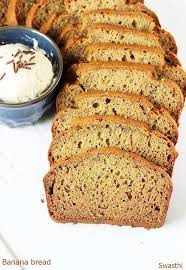I firmly believe that banana bread is something you should be able to make anytime and anywhere, with a mixer or with a fork, in a loaf pan or in a muffin tin — whenever you have a few bananas going soft and freckly. Banana bread Recipe, I’m pretty sure, is at least 50 percent of the reason bananas exist.
Here is a very basic and very forgiving recipe that takes all of 10 minutes to whisk together. An hour of waiting while your house fills with tempting aromas and then you’ll be snacking on your very own slice of warm, fresh-baked banana bread.
Only Use the Ripest Bananas
Just about the only requirement for making banana bread is that you use ripe bananas. Once the skins start to develop freckles and the fruits are just a little too soft for pleasurable snacking, then it’s banana bread time. Letting your bananas ripen even longer — until the skins are brown and the fruit falls apart when you peel it — will make your bread even more strongly banana-flavored and richer.
Let’s also talk for a second about mashing. Personally, I like to leave some banana chunks in my bread and I also like the one-bowl simplicity of mashing the bananas directly into the batter. If you are anti-chunk and like your bananas to be completely smooth, I recommend mashing them into a pulp in a separate bowl and then mixing them into the batter.
A Very Forgiving Recipe
With a very few variations, the recipe I give below is universal to almost every church or community cookbook written in the last 50 years. It’s definitely time-tested! It uses ingredients most commonly found in our pantries: white all-purpose flour, granulated sugar, butter, eggs, milk, and baking soda.
But when I say this is a forgiving recipe, I mean it. You can swap up to half the flour for whole wheat or another favorite whole-grain flour. You can use brown sugar instead of white (which makes a denser, moister bread) or another sugar altogether. You can use margarine or oil for the butter and almond milk, kefir, buttermilk, or even water for the liquid. The bread will be fine with just one egg. I’ve never tested it without eggs, but I suspect this would still make a perfectly snackable loaf.
My point here is that you can still make banana bread even if you find yourself short on one of the other ingredients (except the baking soda — you need that!). You can also get creative and play with these base ingredients to your heart’s content.
Using a Mixer vs. a Fork
If it weren’t already clear by this point, the implied subtitle of this recipe is “don’t fuss; make it easy.” If you find it easier to make a recipe like this in a stand mixer or with a hand mixer, then that’s the method you should use. Personally, I prefer to make it by hand in a bowl the way my mother taught me — that feels somehow easier to me even though the same number of bowls get dirtied.
If you use a mixer, you have two options: you can melt the butter as directed and follow the recipe exactly, or you can leave the butter softened and cream it with the sugar. Creaming the softened butter and sugar will make your banana bread lighter and more cake-like with a finer texture; melted butter makes the bread denser and less crumbly.
What If I Don’t Have A Loaf Pan?
If you don’t have a loaf pan, you can use this same recipe to make eight to 10 banana muffins. Line a muffin tin with paper liners and fill each cup to roughly 3/4 full, and check for doneness after 20 minutes.
Now tell me: How do you make your banana bread? Is your recipe similar to this one? Do you follow a different technique? And the most important question: chocolate chips, nuts, or plain?

























No comments:
Post a Comment